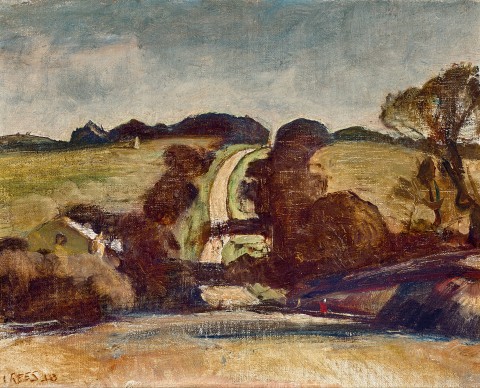COUNTRY ROAD, MOUNT RANKIN, NEAR BATHURST, 1948
LLOYD REES
oil on canvas on board
29.0 x 37.0 cm
signed and dated lower left: L. Rees 48
inscribed with title verso: COUNTRY ROAD, MOUNT RANKIN, NEAR BATHURST.
Artarmon Galleries, Artlovers, Sydney (label attached verso)
Private collection, Sydney, acquired from the above in 1995
The year 1948 was a difficult one for Lloyd Rees marked by a sequence of severe nervous breakdowns that left him bedridden and depressed for days on end. When energised, he would find sustenance by travelling with his wife Marjory to the coast at Werri (where they built a house in 1947) or to the gently sloped lands around Bathurst, New South Wales, on the traditional lands of the Wiradjuri people. Marjory was born in the town and much of her family resided there which meant that Rees could be comfortably looked after as he recovered. Naturally, his expeditions painting in the nearby hills were also a tonic to his fragile condition. He would later recount that ‘we would travel to Bathurst at the beginning of the winter – the early vacation – and again towards the end of winter. And I have memories of waking up in complete stillness at my brother-in-law’s at Mount Rankin, some 8 miles out of Bathurst – in the early days devoid of electricity, or any of those sorts of amenities.’1
In 1942, Rees was honoured with a Retrospective at the Art Gallery of New South Wales, and his friend John Young was quoted in the foreword, noting that Rees ‘has a rarefied sense of light… he is an inspiration to those who share his experience and perhaps an example to those who have personal vision but fear to state it in their own way.’2 Rees exhibited twice in the Archibald and Wynne Prizes in the following years, and in 1946, was appointed as a part-time teacher at the School of Architecture at the University of Sydney. He had visited Europe for a year between 1923 and 1924, which ignited his great love for the Italian landscape and reinforced his respect for works of the European masters, particularly Jean-Baptiste-Camille Corot. Rees saw in the Bathurst hills and the nearby Macquarie Plains ‘a landscape more French than English rural landscape, because it has not been divided by hedges.’3 In Country road, Mount Rankin, near Bathurst, 1948, the view does indeed feel European with its subdued tenor, and Rees likely established his vantage point in Wattle Tree Lane, an unsealed road which leads to the summit. By this time, he had ceased his practice of direct plein air painting and would undertake a preparatory sketch on site, later finished in the studio where he believed ‘a different person seems to take over, the picture on the easel dominates and everything else fades away.’4 He would allow the paintbrush to dictate how the final image would eventuate, often adding, deleting or moving details in the search of direct painterly form. For example, in Country road, Mount Rankin, near Bathurst, the normally verdant green of winter pastures are reduced to more sombre tones, and it is likely Rees adjusted the position of one of the two houses to act as counter-balance for its companion. The ambiguous dark shadows across the road likewise provide a horizontal emphasis which contrasts the soft curves of the road, trees and hills, and the feathered edges of the blustery clouds overhead.
1. Lloyd Rees in Lloyd Rees: an artist remembers, Craftsman House, Sydney, 1987, p. 55
2. John Young cited in ‘Lloyd Rees’, Lloyd Rees Loan Exhibition, National Art Gallery of New South Wales, Sydney, 1942, p. 6
3. Lloyd Rees, op. cit.
4. Rees, L., Peaks and Valleys: an autobiography, Collins, Sydney, 1985, p. 227
ANDREW GAYNOR
